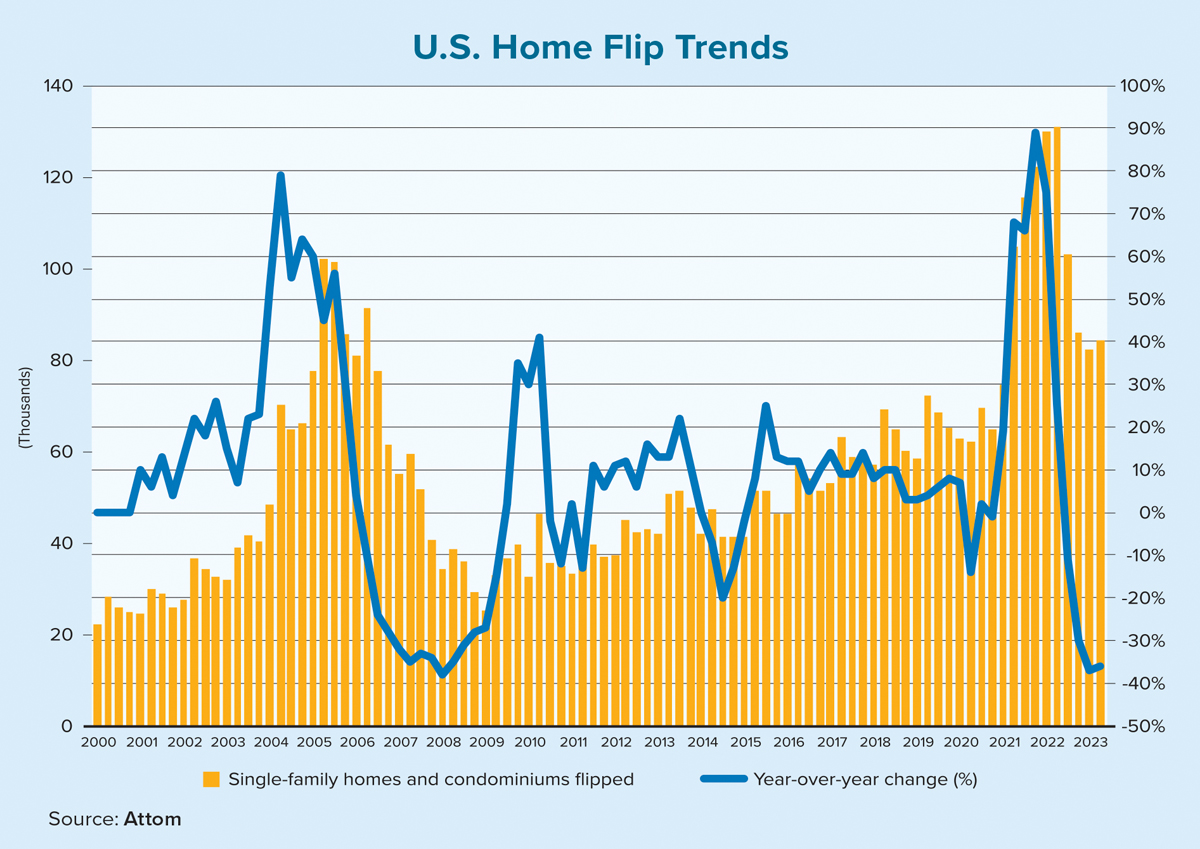Retail prices across the U.S. housing market rebounded in second-quarter 2023 — and so did the profits for home flippers. This bump in profit margins, however, occurred even as the fix-and-flip share of all home sales dipped near a two-year low point, according to the Q2 2023 U.S. Home Flipping Report from Attom.
From April through June, flips represented 8% of all sales, down from the 9.9% share seen in Q1 2023 and down from the 8.9% share in Q2 2022. While this was still a high rate, historically speaking, the decline is a trend to watch. Notably, the average time from investor purchase to resale for a home flip increased to 178 days in the second quarter, marking the longest period since mid-2020.
Despite the longer time to resale, raw profits and returns on investment (ROI) increased for a second quarter in a row, marking signs of recovery from a slump over the prior two years. ROI climbed by nearly 5 percentage points between the first and second quarters, the fastest pace since 2020, while raw profits jumped by 18% in the same time frame, a quarterly spike not seen in the past 10 years.
These improvements mirrored the housing market at large. The single- family median home price rose by 10% during the spring buying season, following steady declines from mid-2022 through early 2023.
In fact, the gross profit on the typical home flip (the difference between the median purchase price paid by an investor and the median resale price) rose to $66,500 in Q2 2023, up from $56,250 in the prior quarter. This was a significant year-over-year decline of 35%, however, as the gross profit on a typical transaction in Q2 2022 was $102,063.
The typical gross profit for a flip in the second quarter represented a 27.5% ROI compared to the original purchase price. This marked a turnaround from the 22.9% ROI posted in Q1 2023 and the recent low point of 22.3% in Q4 2022. It was still far below the peak ROI of 61% in Q2 2021, but fix-and-flip profits are seeing a clear and steady uptick.
The typical resale price for a flipped home rose by 2.1% between the first and second quarters to reach $308,500. This contrasted with a 1.6% decline in the median purchase price for the investor during the same period. And it was a reversal of the trend in which prices and profits for fix-and-flip projects ran counter to the U.S. retail housing market, which has seen an extended boom for the past decade.
Although the rate of home flips dropped in the second quarter, real estate often remains a local endeavor, and investors should make note of the places where flips are thriving. Attom analyzed metro areas with a population of 200,000 or more that had at least 50 home flips in Q2 2023. The top-five metros included Macon, Georgia (where flips accounted for 16.8% of all home sales); Columbus, Georgia (15.3%); Spartanburg, South Carolina (13.5%); Atlanta (13.5%); and Akron, Ohio (12.5%). Among metro areas with a population of 1 million or more, the highest shares of flips were recorded in Atlanta, Memphis, Jacksonville, Cincinnati and Phoenix.
In addition, some metros are providing bigger returns on investment for these projects. In Q2 2023, these locations included Akron, Ohio (116.7% ROI); Pittsburgh (112.9%); Scranton, Pennsylvania (93.7%); Hagerstown, Maryland (86.6%); and Trenton, New Jersey (85%). In metro areas with populations of at least 1 million, the highest ROIs were found in Pittsburgh; Baltimore; Philadelphia; Rochester, New York; and Richmond, Virginia.
Although there are many positive signs for the fix-and-flip market, uncertainties remain. The increases in gross profits and margins are heartening, despite the decline in the flip rate. But it remains to be seen whether these pricing improvements are a reflection of the yearly bumps seen during the busy spring purchase season or are representative of a more lasting measurement for profits on a home flip project. ●
Author
-

Rob Barber is CEO of Attom, curator of the nation’s premier property database. After joining the company in 2015, Barber spearheaded the creation of the Attom Data Warehouse. A 25-year veteran in the real estate information-services industry, Barber directs the ongoing product innovation that leverages the company’s data warehouse and data-delivery platforms, which fuel real estate transparency.





